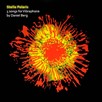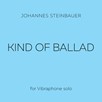
Lyrical Studies for The Contemporary Vibraphonist
Composer: David Friedman
Instrument: Vibraphone
Level: Intermediate/Advanced
Published: 2024
Price: €30.00
Item details
-
Description +
-
When “Vibraphone Technique, Dampening and Pedaling” saw the light of day almost 60 years ago, I would never have dreamed of its impact on the evolution of the vibraphone world wide. My motivation for writing it was quite simple. It started with a question; How can I inspire students and colleagues to invest their time and energy in the creation of an illusion, not unlike a magician’s “sleight of hand”? The “illusion”, in this case, is the development of techniques which make a percussive melodic instrument sound like the human voice. The ultimate example of this is the human voice, the sonic representation of true lyricism. The best compliment I ever got from a critic was, “Friedman sings on his instrument”. It encouraged me to continue confronting the challenges of trying to overcome the natural limitations of the vibraphone. The human voice has been and still is my goal. What are the specifics in getting there? The broad answer is, phrasing in the most sophisticated manner; using dampening to create true legato, slurs, exaggerating dynamics between notes, employing the proper pedaling to support the effect, and all of this perhaps within the phrasing of one measure. The result of this conscious phrasing can be lyricism, the “illusion” of being a violin, saxophone, clarinet, or, at best, the human voice. We can learn to “sing” on our instrument: Lyricism and melody are often synonymous, but not always. We think of a beautiful melody as having a lyrical arc, connecting the notes in a legato fashion, most fitting for the human voice. A melody can also have the opposite quality. It can be “pointillistic” in nature, with short, staccato notes, seemingly disconnected. This kind of melody is perfect for the tempered instrument. On the vibraphone, one can simply avoid using the pedal and play without dynamics.
With my new book, “Lyrical Studies for The Contemporary Vibraphonist”, the focus is on lyrical playing, introducing phrasing and pedaling techniques, which build on the challenges in “Vibraphone Technique, Dampening and Pedaling”. Here, different styles of playing are introduced. One can listen to the audio file of each piece, or “etude”. Visual examples of how to execute certain phrasing techniques are also included. Although each piece was an improvisation, each one is based on a musical idea and specific phrasing challenge. I hope you enjoy playing them as much as I did creating them.
One quick thought: Because the etudes were improvised, there are some small discrepancies between the phrasing of the “examples” and the etudes themselves. I did my best to play the “examples” as close to the originals as possible. However, striving for perfection can sometimes be the enemy of spontaneous creation.David Friedman, Berlin, Feb.10th, 2024
Table of Contents
1. Slow Groove
2. Slow Lyrical
3. 6ths
4. 1/2 Step Dampening
5. Major 7th and Diminished Triplets
6. Other World Harmonies
7. New Polyphonic Groove
8. 3rds Cakewalk
9. Country in 4
10. Polyphonic Miniature
11. New Polyphonic Rubato
12. Freddie Green Blues
-
-
Instrumentation +
-
Vibraphone
-
-
Watch+
-
Performed by David Friedman
-
-
About the composer +
-
David Friedman is considered to be one of the most influential vibraphonists in the history of the instrument. Internationally renowned as a vibraphonist, marimbist, composer and educator, he has his own musical message, born of fascinatingly diverse musical influences.
Having worked with such varied musical personalities as Leonard Bernstein, Luciano Berio, Bobby McFerrin, Wayne Shorter and Yoko Ono, few jazz musicians can claim as broad a spectrum of performance and recording experience.
The list doesn’t stop there. Friedman has been heard either live or on recordings with, among others, Joe Henderson, Horace Silver, Johnny Griffin, Ron Carter and John Schofield. Friedman’s vibraphone and compositions are both featured on Chet Baker’s award winning Enja Records release, “Peace”, with bassist Buster Williams and drummer, Joe Chambers.
A dedicated and renowned educator, Friedman founded the jazz program at Berlin’s University of the Arts and served as its head for 16 years. His book, “Vibraphone Technique, Dampening and Pedaling”, is considered to be the Bible of mallet instruction books.
Friedman has been awarded Life achievement awards from the Ludwig Albert International Marimba Festival, The KoSa Percussion Academy and the Italy Percussion Festival.
In addition, he was inducted into the Percussive Arts Society Half of Fame in 2015.
David continues composing for various ensembles and performing and recording with his “Generations Trio”, setting a new standard in spontaneous music creation in this innovative trio setting.
-
-
Reviews +
-
Percussion Creativ, October 2024
David Friedman's life work as an artist and vibraphonist is unparalleled and deserves the highest recognition. Equally important are his contributions as an educator and as an inventor of methods for developing instrumentalists. With the present lyrical studies, he has created yet another standard work for vibraphone, which, alongside various technical challenges, focuses on interpretation and musical expression. The human singing voice serves as a challenging model for his idea of phrasing, with the following goal: through the use of pedaling, mallet dampening, and legato playing, a dynamic relationship between individual notes is to be naturally developed.
The educational concept appears in a modern format. Each study is accompanied by a practice field, where the essential aspects of the study are introduced. The practice field and study can be conveniently played as audio via QR code on the Edition Svitzer YouTube channel. Would one have wished to see the master perform there in video format? No, the decision is correct! The ear hears more when the eye does not see.
Each lyrical study appears in its own distinct tonal color and theme. They are comfortable to play, evolve into true concert pieces by the end of the collection, and provide joy at every level.
—Jochen Schorer
-
-
Credits +
-
With support from Koda’s Cultural Funds
Front Cover Graphics and Layout: Nicola Lee
Copyright © Edition SVITZER
www.editionsvitzer.com
-








